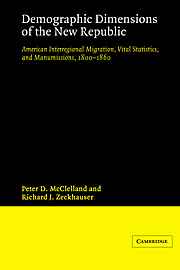 Demographic Dimensions of the New Republic
Demographic Dimensions of the New Republic Published online by Cambridge University Press: 19 September 2009
Overview: 1800–60
Among the puzzles raised by the demographic statistics for the American white population of this period, two are particularly noteworthy. The first, as indicated at the outset of this study, is how exceptional the growth record was by contemporary world standards. The main explanation of this record, as documented by previous immigration calculations, was the exceptional rate of natural increase of the local population. The second concerns the sharp discontinuity in estimated rates of natural increase, a discontinuity that remains for all reasonable variations in the assumptions underlying these estimates. Why was the domestic rate of natural increase so atypical, and what caused it to change so dramatically in the period 1800–1860?
That American birth rates were exceptionally high in the latter part of the eighteenth century was a commonplace among contemporary observers. Their explanations stressed abundant land, high living standards and a propensity to marry early. Death rates were ‘low’. The rural and dispersed population was better fed and less subject to contagious and infectious diseases – or so the argument ran. Whether death rates were considered to be unusually depressed by European or world standards is not clear. The exceptional nature of birth rates was never questioned.
American demographers are agreed that during the first half of the nineteenth century birth rates fell quite rapidly. Such factors as urbanization, rising incomes, and changing land availability are usually cited as contributing to a rise in marriage age and a fall in the incidence of marriage.
To save this book to your Kindle, first ensure [email protected] is added to your Approved Personal Document E-mail List under your Personal Document Settings on the Manage Your Content and Devices page of your Amazon account. Then enter the ‘name’ part of your Kindle email address below. Find out more about saving to your Kindle.
Note you can select to save to either the @free.kindle.com or @kindle.com variations. ‘@free.kindle.com’ emails are free but can only be saved to your device when it is connected to wi-fi. ‘@kindle.com’ emails can be delivered even when you are not connected to wi-fi, but note that service fees apply.
Find out more about the Kindle Personal Document Service.
To save content items to your account, please confirm that you agree to abide by our usage policies. If this is the first time you use this feature, you will be asked to authorise Cambridge Core to connect with your account. Find out more about saving content to Dropbox.
To save content items to your account, please confirm that you agree to abide by our usage policies. If this is the first time you use this feature, you will be asked to authorise Cambridge Core to connect with your account. Find out more about saving content to Google Drive.